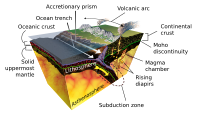
Photo from wikipedia
Abstract The Makran subduction zone is one of the world's least well documented active subduction zones. We investigate the geometry of subsurface velocity interfaces across the western coastal Makran by… Click to show full abstract
Abstract The Makran subduction zone is one of the world's least well documented active subduction zones. We investigate the geometry of subsurface velocity interfaces across the western coastal Makran by means of teleseismic data for the first time. The data were gathered by two permanent and four temporary seismic stations. We calculated P receiver functions and jointly inverted them with surface wave dispersion data to generate a 2-D shear wave velocity model. Employing this model, we migrated receiver functions to depth and show two gently northward dipping interfaces at depths of 9–15 km as the base of the accretionary wedge and 27–31 km as the Moho boundary. 360-degree periodic amplitude variation of the Ps pulse at 0.4 s and 1.4 s are modeled as an anisotropic layer between 2 and 9 km near the Makran shoreline. We interpret this layer as a signature for the accretionary prism of the subduction zone beneath the coastal Makran. One interesting observation is that all multiples of the Moho pulse have a twin. By H-κ stacking of receiver functions, we showed that the twin multiples of the Moho boundary could be a signature of a thin (~ 4.5–7 km) high velocity oceanic crust located at a depth range of 24.5 km to 31.5 km. Our new model for western Makran shows that the coastal Makran is still on the oceanic lithosphere and the filled trench is located almost 200 km north of the active accretion front. This different geometry for the subduction has implications for the location and rupture parameters of future potential megathrust events which, in the western Makran, could have significant influences on seismic hazard, tsunami propagation and thermal structure modeling of the subduction zone.
Journal Title: Tectonophysics
Year Published: 2020
Link to full text (if available)
Share on Social Media: Sign Up to like & get
recommendations!